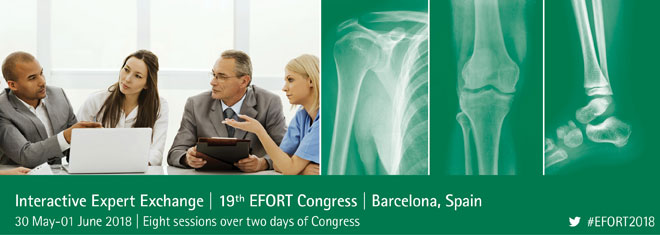Experts to focus on bicondylar/complex proximal tibial plateau fractures at 19th EFORT Congress

Are you often thrilled with the need to decide which is the best therapeutic approach when treating a bicondylar/complex tibial plateau fracture? Depending on the complexity of the fracture, should you give preference to one or another surgical approach? The Friday program of the upcoming EFORT Congress in Barcelona showcases an Interactive Expert Exchange (IEE) session under the topic Knee & Lower Leg Trauma to answer these specific questions of your daily practice.

Fractures of the tibial plateau (classified as AO/OTA 41C1, 41C2, 41C3 types or Schatzker V, VI types or Luo two- or three-column types) constitute the most difficult group of fractures of the proximal tibia, as the tibial condyles have sustained variable degree of displacement and/or depression. In many cases, significant soft tissue injury has also occurred (severe skin contusion, meniscal and ligament tears, neurovascular problems, etc.). These injuries require an individualized multifactorial approach, and the decision for selecting one or another surgical technique for management can be crucial for the patient’s outcome.
To facilitate the decision-making process, this session will address the considerations prior to listing for surgery, as well as all the criteria for the selection of the best treatment option. The latest data regarding current treatment strategies and operative techniques (established and new) will be presented by a multinational panel of experts, which will reveal the best tips and tricks to avoid complications and ensure the best outcome for the patient.
Complex Proximal Tibial Fractures: Plates, Fixators or Nails?
Friday 1 June 2018 | 10:00 – 12:15
Introduction & Conclusions
Christos Garnavos (Greece)
Questions & Presentations
- Overview and treatment strategies for complex tibial plateau fractures – Peter Giannoudis (United Kingdom)
- Bicondylar tibial plateau fractures: Treatment with plates – Christian Krettek (Germany)
- Bicondylar tibial plateau fractures: Treatment with external fixators – Paul Harwood (United Kingdom)
- Bicondylar tibial plateau fractures: Treatment with intramedullary nails - Christos Garnavos (Greece)
- Bicondylar tibial plateau fractures: Complications and outcomes – Cristoph Pape (Switzerland)
Discussion of Clinical Cases
Michiel Verhofstad (Netherlands) and Jörg Franke (Germany)
Speakers will deeply analyze the incidence of ligamentous injury in the context of a bicondylar/complex tibial plateau fracture, as well as expose the incidence of secondary collapse of the articular surface. Moreover, faculty members will highlight the decisive factors to consider for selecting the appropriate fixation strategy and give their best advice on how to deal with bone defects and cartilage damage. The latest evidence on best plating practice, as well as the expert advice on how to use the circular frames alongside with the corresponding results in regard to stabilization, mobilization and functional rehabilitation will be extensively discussed. The recently introduced technique that implements intramedullary nailing and compression bolts will be presented and the rationale for such a development will be discussed. The necessity for regular use of MRI to assess soft tissue lesions and the techniques to address the posteromedial fragment are some additional topics that will complete the program of this session.
Finally, a short discussion about critical issues to consider in the treatment of complex proximal tibial plateau fractures will include information about risk assessment for the soft tissues that surround the fractured proximal tibia, intraoperative compromised reduction, postoperative loss of reduction and malunion, and predisposing factors for other complications, such as infection or fracture healing problems.

The lectures, debates and clinical case presentations from well-known orthopaedic surgeons will guide the audience to a deep-seated appreciation of how to offer optimal individualized treatment to patients with intra-articular complex fractures of the proximal tibia.
IEEs are paying sessions and pre-registration is mandatory on a first-come, first-serve basis (maximum of 200 participants). Only participants with a full registration for the congress can attend the IEE sessions. Details to sign up will be available on the registration platform as of January 2018. Visit the Barcelona congress website regularly.
- For more information:
- 19th EFORT Congress in Barcelona | 30 May-1 June 2018
- IEE session
